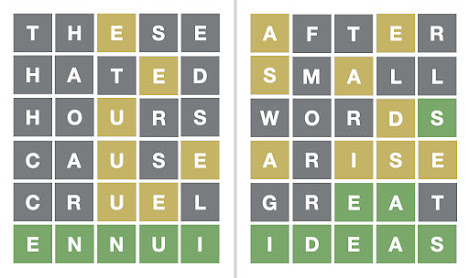[Pictures: Wordle Lits by AEGN, 2022.]
June 29, 2022
Words of the Month - Wordle Lit
June 24, 2022
Who Is Catching Whom?
[Picture: Big Catch, rubber block print by AEGN, 2022.]
June 20, 2022
Juneteenth
[Pictures: Magic People, linoleum cut by Elizabeth Catlett, 2002 (Image from Cleveland Museum of Art);
Innervisions 2 (Unfurling), relief block print by Deborah Grayson (Image from GraysonStudios.com);
Liberty, linoleum block print by Peter Paul Piech, 1971 (Image from V&A).]
June 15, 2022
Fantasy Botany
[Pictures: Mandrake, wood block print from Ortus sanitatis by Johann Prüss, 1499 (Image from Internet Archive);
My Lady’s Garden, color wood block print by Walter Crane from The Baby’s Opera, printed by Edmund Evans, c 1877 (Image from International Children’s Digital Library);
Mary, Mary, illustration (possibly by Howard Del?) from Mother Goose’s Melodies for her Little Goslings, 1881 (Image from International Children’s Digital Library);
Two plants from Voynich Manuscript, c 1401-1599 (Image from Yale University Library);
Illustrations from Codex Seraphinianus, by Luigi Serafini, 1981;
Illustration from The Land of Neverbelieve by Norman Messenger, 2012.]
June 10, 2022
Shining the Light through Block Prints
[Pictures: Stained glass from Yale’s Humanities Quadrangle, 1932 (photos by AEGN, 2022);
Der Formschneider, wood block print by Jost Amman from Eygentliche Beschreibung aller Stände auff Erden, 1568 (Image from Yale University Library);
Theatrum, wood block print from Comoediae by Terence, 1493 (Image from National Gallery of Art);
Title Page, wood block print from Libre de consolat tractant dels fets maritims, 1502 (Image from Sotheby’s);
Trevithick’s Locomotive, wood engraving (by H.W. Benno?) from The Progress of Invention in the Nineteenth Century by Edward W. Byrn, 1900 (Image from Internet Archive).]
June 6, 2022
Picasso Poster
[Picture: Exposition Vallauris, linocut by Pablo Picasso, printed by Imprimetie Arnéra, 1956 (Image from AEGN, at the National Gallery of Scotland).]






















